Matlab competetive environment simulation
15. Jún, 2011, Autor článku: Dostál Petr, MATLAB/Comsol
Ročník 4, číslo 6  Pridať príspevok
Pridať príspevok
![]() The article deals with the build-up of a model for competitive environment simulation. It presents the model, explains the used variables and their interpretation in the competitive environment. The possible use is in various branches. The two dimensional partial differential equation of second order is used for the simulation as a support of decision making process.
The article deals with the build-up of a model for competitive environment simulation. It presents the model, explains the used variables and their interpretation in the competitive environment. The possible use is in various branches. The two dimensional partial differential equation of second order is used for the simulation as a support of decision making process.
1. Introduction
The two dimensional partial differential equations of second order can be used for the simulation of competitive environment in various branches. The article presents the equation necessary for calculation, explains the used variables and their interpretation in the competitive environment. The use of competitive environment simulation is described generally and it includes various branches.
2. Theory
Two dimensional partial differential equations of second order is used for the simulation of competitive environment in the form
The used differential equation [Dostál 2008] is in the form
where
3. Build-up simulation Model
The model was build-up for the simulation of the competitive environment. The input K is a simulation constant, the constants matrixes Kxi,j (n x m) and Kyi,j (n x m) present the rate of “resistance” of competition environment in the direction of coordinates x, y of each cell and matrix U0,i,j(n x m) represents the initial conditions of utilization in time T0 = 0. The value of Tend is the end time of simulated process. The meaning of used variable in the competitive environment simulations is as follows: The values of “cells” represent the utilization of searched objects Ut,i,j with index of time t and coordinates i, j.
The utilization is in the range from 0% to 100%, where 0% means the zero utilization and 100% means the maximum utilization. The various conditions and situations and their changes in time create the dynamic competitive environment. The variable of utilization U has the first derivative U’ that presents the dynamic change of utilization and the second derivative U’’ presents the acceleration of utilization.
4. The use of build-up model
The model for simulation is programmed in MATLAB software. The grid 10 x 10 is used for simulation, where the searched objects are placed. Fig.1 presents the results of competitive environment simulation with the help of two and three dimensional graph. The spectrum of colours is used from green (0%), via yellow (50%) to red (100%) and it presents the utilisation U (axis z) of searched objects in x and y coordinates in end time. Each cell has a colour that corresponds with the value of the utilization U of searched object. The various simulation can be made by changing the conditions and various end time.
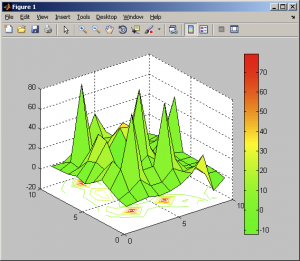
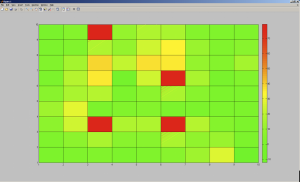
Figure 1: Results of utilization shown by two and three dimensional graph
The polar graph could be used for evaluation of results where the utilization of various objects could be compared in time. The utilization U of six objects is shown at the start (dotted green line), medium (dashed blue line) and end (red line) time t. See fig.2.
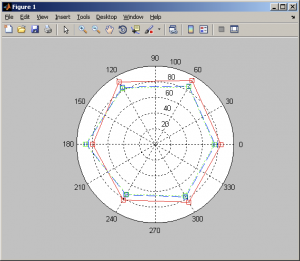
Figure 2: Results of utilization shown by polar graph
The time dependence t on utilization U of searched object (cell) could be shown. Also speed U’ and acceleration U’’ of utilization (y axis) in time t (x axis) could be shown. See fig.3.
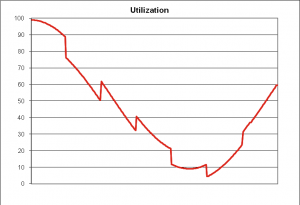
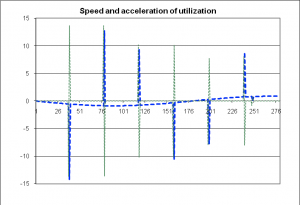
Figure 3: Results of utilization show the time dependence
Some searched objects have high utilization, another lower or low utilization. This dependence could be generated by defined functions and partially by chaotic and pseudorandom generator. The objects influence each other.
5. Conclusion
The designed methodology enables to simulate the competitive environment where the utilization of searched objects is the output. The simulation can be very important and its results can be used for decision making processes. The calculation can support the decision making processes of managers. It can help to reduce the losses and increase to profit to avoid bad decision. The designed methodology can be used for example for the branch of hotels, hospitals, banks, petrol stations, firms, supplier-customer relations etc.
References
- DOSTÁL, P. Competitive Environment Simulation. Kunovice 26.1.07, 2007, In 5th International Conference on Soft Computing, p.207-212, ISBN 80-7314-108-6.
- DOSTÁL P. Advanced Economic Analyses. CERM, Brno 2008, 80 p., ISBN 978-80-214-3564-3.
- DOSTÁL, P. Pokročilé metody analýz a modelování v podnikatelství a veřejné správě. (The Advanced Methods of Analyses and Simulation in Business and Public Service – in Czech), CERM, Brno, 2008, 432 p., ISBN 978-80-7204-605-8.
- DOSTÁL P. Prediction of Competitive Environment in Business. In 28th International Symposium on Forecasting. Nice, France, June 22-25, 2008, p.171, 6p., ISSN 1997-4116, ISSN 1997-4124.
- DOSTÁL P., KRATOCHVÍL, O. The Prediction of Hospital Competitive Environment, In 29th International Symposium on Forecasting. Hong-Kong, June 24-26, 2009, p.171, 5 p., ISSN 1997-4116.
- DOSTÁL P., LEVENBACH, H., SAVAGE, P. The Competing for New Hospital Locations: A Simulation Modeling Approach. In 29th International Symposium on Forecasting, Hong-Kong, June 24-26, 2009, p.171, 5 p., ISSN 1997-4116.
- DOSTÁL P., KRATOCHVÍL, O. Decision Making for Closing Branch of Bank: A Simulation Model. In 30th International Symposium on Forecasting. San Diego, USA, June 26-29, 2010, 6p., ISSN 1997-4116.
- DOSTÁL P. Decision Making in Economy and Management by Means of Fuzzy Logic with the Support of Classical Methods. In 16th International Conference on Computing in Economics and Finance. London, Great Britain, July 15-17, 2010, 6p.,
- THE MATHWORKS. MATLAB – User’s Guide, The MathWorks, Inc., 2010.
Coauthor of the paper is Oldřich Kratochvíl, Faculty of Business and Management, Department of Informatics, Kolejní 4, 612 00 Brno

